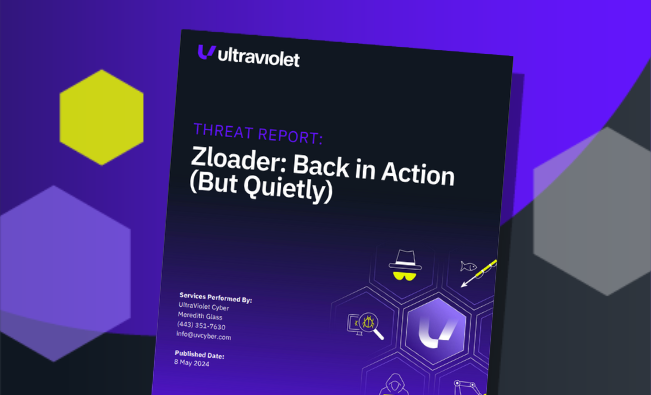
Zloader: Back in Action (But Quietly)
Zloader malware is back in action! This in-depth technical analysis unveils its latest attack methods, explores its evolution, and provides crucial detection helping organizations minimize security risks...
Find flaws in web, mobile, and IoT applications.
Expose risks in AWS, Azure, and GCP environments.
Ongoing testing to catch real-world vulnerabilities as they appear.
Live-fire exercises to sharpen detection and response.
Time-boxed security assessments across networks, apps, and infrastructure.
Simulated attacks to test detection and incident response.
Named security experts integrated seamlessly into your team.
Real-time detection and automated threat response.
24x7 monitoring and response by expert analysts.
Nonstop scanning to prioritize and reduce risk.
Ongoing scanning, triage, and compliance tracking.
Unified security platform powering all UV services.
Cross-platform toolkit for advanced red team ops.

Secure your code, infrastructure, and deployment pipelines before attackers exploit them.
September 19, 2025
August 27, 2025
June 26, 2025
UltraViolet Cyber is a practitioner-led MSSP delivering offensive and defensive security to Global 2000 and Federal clients. Built by former intelligence operators, we unify application security, red teaming, detection, and engineering under one roof. Our UV Lens platform replaces silos with integrated, outcome-driven operations.
UltraViolet Cyber
MYTH #1: ZERO-TRUST IS A BUZZWORD, NOT A NECESSITY.
MYTH #2: ENDPOINT SECURITY IS ALL ABOUT ANTIVIRUS.
MYTH #3: PATCHING IS A CHORE, NOT A PRIORITY.
MYTH #4: CLOUD SECURITY IS SOMEONE ELSE'S PROBLEM.
MYTH #5: HUMAN ERROR IS A NUISANCE, NOT A THREAT.
MYTH #6: AI WILL SOLVE OUR SECURITY WOES.
MYTH #7: ENCRYPTION IS IMPENETRABLE ARMOR.
MYTH #8: INCIDENT RESPONSE IS REACTIVE, NOT STRATEGIC
MYTH #9: OPEN-SOURCE SECURITY TOOLS ARE INHERENTLY INFERIOR
In the ever-evolving landscape of cybersecurity, myths and misconceptions can hinder our understanding and compromise our defenses. Let's unravel and dispel ten common cybersecurity myths that persist in the digital realm, drawing insights from real-world examples that highlight the importance of addressing these misconceptions.
Many enterprises still rely on perimeter defenses like firewalls, believing they're enough to stop attackers. This mindset stems from the outdated "castle-and-moat" approach, where threats were external and easily identified.
The SolarWinds supply chain attack in 2019, where trusted software vendors inadvertently distributed malicious updates, exposed the fallacy of blindly trusting even seemingly reputable sources. Adopting a zero-trust approach becomes imperative to prevent lateral movement and contain such sophisticated attacks.
Antivirus is often treated as a magic bullet, the ultimate protection against all cyber threats. This outdated perception leads to overreliance on a single tool, neglecting additional layers of defense. Modern malware, like ransomware and polymorphic variants, can easily bypass traditional antivirus signatures, leaving systems vulnerable.
The WannaCry ransomware outbreak of 2017 exploited unpatched vulnerabilities in Windows systems, crippling operations at hospitals and businesses globally. Traditional antivirus failed to stop the attack, highlighting its limitations against zero-day vulnerabilities and sophisticated malware. Endpoint Detection and Response (EDR) and XDR tools, offering behavioral analysis and anomaly detection, provide a more effective shield against these evolving threats.
Procrastinating on patching vulnerabilities is often seen as a minor inconvenience, prioritized over other business functions. This mindset stems from the perception of patching as a time-consuming and disruptive process. However, unpatched vulnerabilities are akin to leaving your front door wide open, inviting attackers to exploit them.
The Equifax data breach, attributed to unpatched software, showcased the severe consequences of neglecting patch management. Recognizing the critical role of timely patches in averting cyber disasters is essential for organizations striving to maintain robust security postures.
The shared responsibility model in cloud security can lead to confusion and complacency within enterprises. Many believe cloud providers solely handle security, neglecting their own responsibilities in securing data and configurations.
The Capital One breach of 2019 occurred due to misconfigured cloud storage. Hackers exploited this misconfiguration to access and steal millions of customer records. This incident highlights the importance of enterprises understanding their own cloud security responsibilities, implementing proper access controls, and employing encryption-at-rest for sensitive data stored in the cloud.
Phishing emails, social engineering tactics, and accidental data leaks are often perceived as minor annoyances caused by human error. This underestimates the significant role human vulnerabilities play in successful cyberattacks. Think of it like leaving a backdoor open in your castle, trusting everyone who knocks.
The Emotet malware campaign of 2021 relied on sophisticated phishing emails that bypassed traditional spam filters. These emails tricked users into downloading malware, infecting their systems and spreading throughout networks. This incident highlights the need for robust security awareness training, simulated phishing attacks, and a culture of security within organizations to mitigate human error and its potential consequences.
The rise of artificial intelligence in cybersecurity fuels the belief that AI will become the ultimate security savior. However, over-reliance on AI presents its own set of risks. Biases in training data can blind AI to certain threats
The Tay AI chatbot incident on Twitter, manipulated into spreading offensive content, showcased the vulnerabilities of unsupervised AI. Combining AI with human expertise is essential for effective cybersecurity, preventing unintended consequences and malicious exploitation.
Encryption is often viewed as an unbreakable shield, completely protecting data from attackers. While encryption is a powerful tool, it's not an absolute solution. Brute-force attacks, advancements in quantum computing, and social engineering tactics aimed at stealing encryption keys can still crack even the strongest ciphers.
In 2017, attackers leveraged stolen user credentials to decrypt and access sensitive data within a healthcare provider's encrypted databases. This incident underscores the need for multi-layered encryption strategies, robust key management practices, and vigilant monitoring to fully protect sensitive information.
Waiting for a breach to occur before taking action is a recipe for disaster. This reactive approach overlooks the immense power of proactive incident response to prevent or minimize damage from attacks.
The 2022 Log4j vulnerability, discovered through proactive threat hunting by researchers, was patched before widespread exploitation. This highlights the effectiveness of proactive measures like threat hunting, vulnerability assessments, and incident response plans in mitigating risks and preventing major breaches.
Open-source security tools often face prejudice due to misconceptions about their reliability and effectiveness. However, these tools like Nmap and Suricata offer valuable capabilities for enterprises on a budget.
During the SolarWinds supply chain attack, open-source tools like Suricata played a crucial role in detecting malicious activity and mitigating the threat. This case showcases the effectiveness of open-source tools alongside proprietary solutions for building a diverse and adaptable defense network.
Viewing security solely as an expense ignores its contribution to business success. Investing in robust security builds trust with customers, attracts new partners, and ensures compliance with regulations.
The aftermath of major data breaches, such as those faced by Yahoo and Equifax, underscores the tangible costs and reputational damage associated with lax security measures. Investing in cybersecurity is not just a cost; it is a strategic move that protects assets, fosters trust, and can be a competitive advantage.
Conduct a security audit to identify vulnerabilities and prioritize patching.
Implement Zero-Trust security principles to verify and control access.
Utilize EDR and XDR tools to identify advanced threats.
Invest in proactive incident response strategies.
Combine open-source and enterprise solutions to build a diverse defense network.
Promote a culture of security within your organization.
Start your journey towards a more secure future, one myth at a time!
We’re here to help. Get in touch for an initial conversation with one of our security experts and learn more about how UltraViolet Cyber can help you take cyber readiness and resilience to new levels.